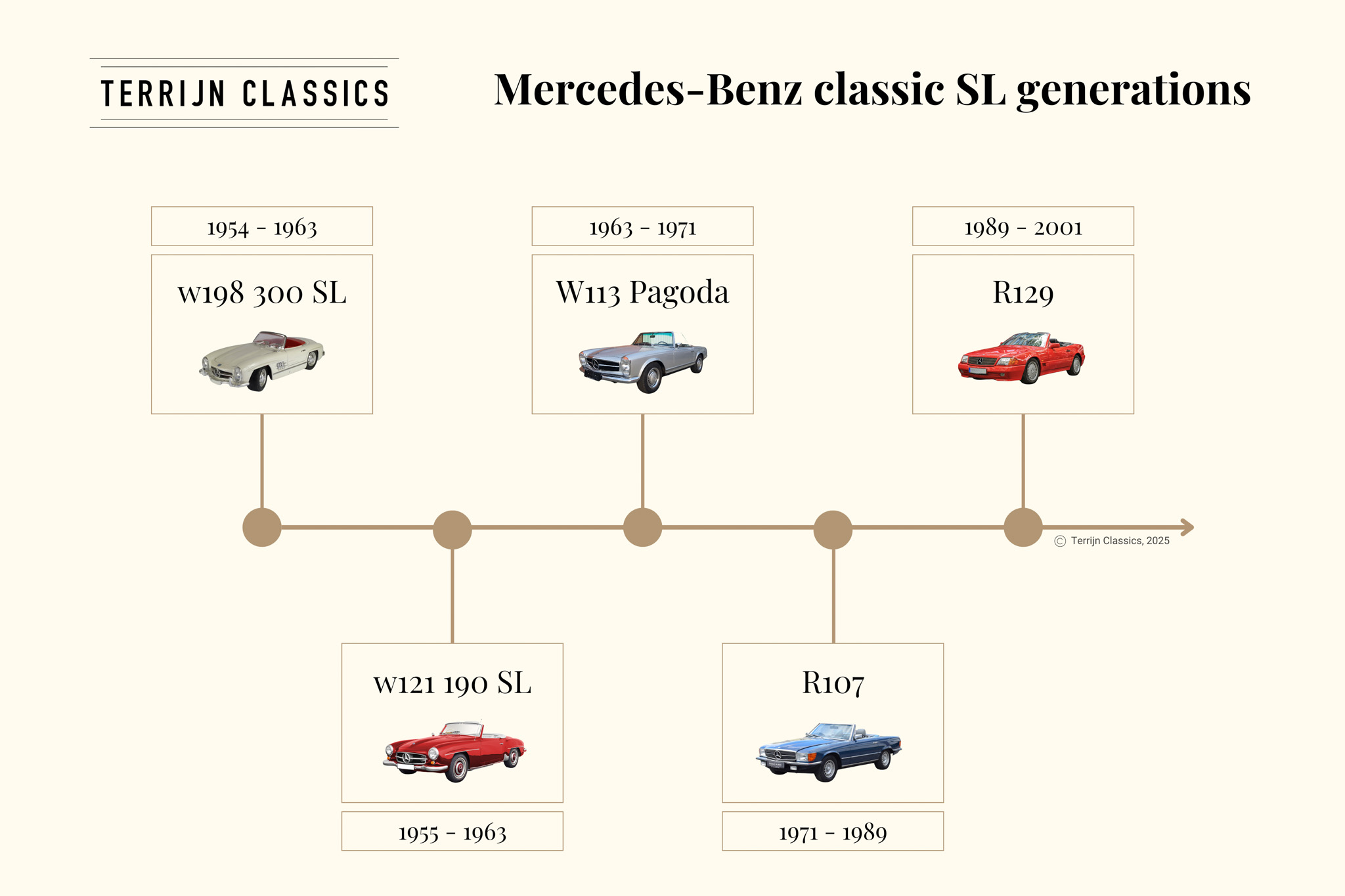The different Mercedes SL classic cars
The Mercedes-Benz SL is a true icon in the world of classic cars. This legendary model series has been around since the 1950s and continues to evolve to this day. Known for its timeless combination of elegance, quality, and a pleasurable driving experience, the SL has always been one of Mercedes-Benz’s most luxurious models. These cars were equipped with the best engineering and technology of their time, which is why even models from the 1950s still impress with their smooth driving performance. By the 1980s, many models were already fitted with modern features such as electric mirrors and heated seats.
Each generation of the SL has brought new versions, trims, and facelifts, offering something unique for every enthusiast. Every classic Mercedes SL delivers a reliable and enjoyable driving experience, though certain models are more desirable than others. The best choice for you will depend on your budget, goals, and how you plan to use the car.
Below, you’ll find a detailed overview of each generation of Mercedes-Benz SL classic cars. Here, you can explore more about each model, what to expect, and the available variants. If you’d like more information or assistance, feel free to get in touch with us.

The different SL generations
1. Mercedes-Benz 300 SL W198
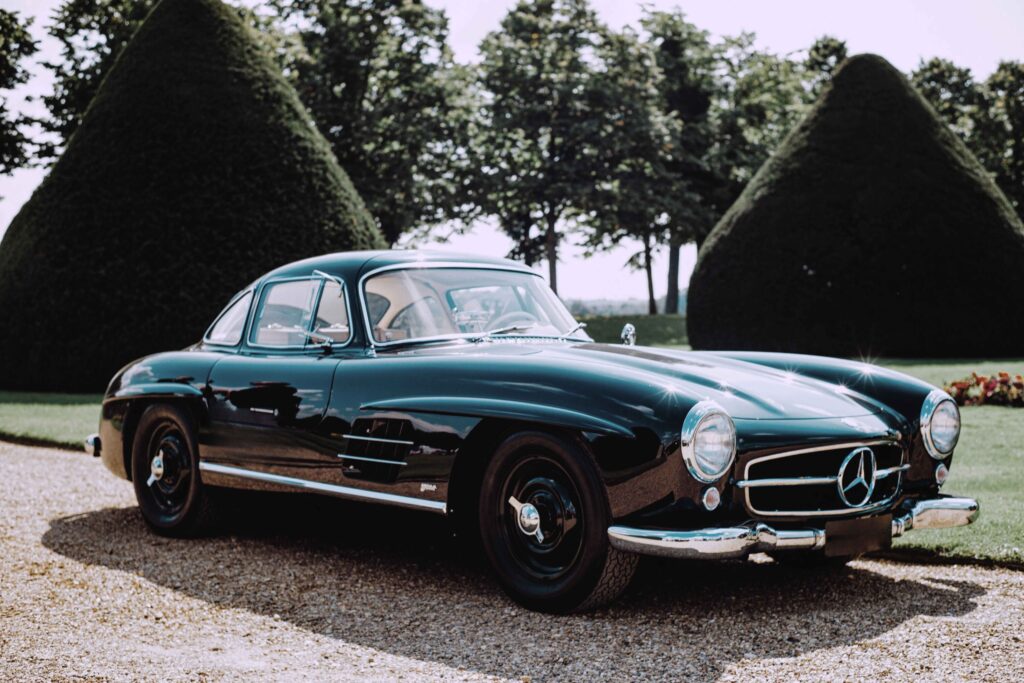
- M198 3.0 liter engine
- 225 hp
- € 1M – 3M+
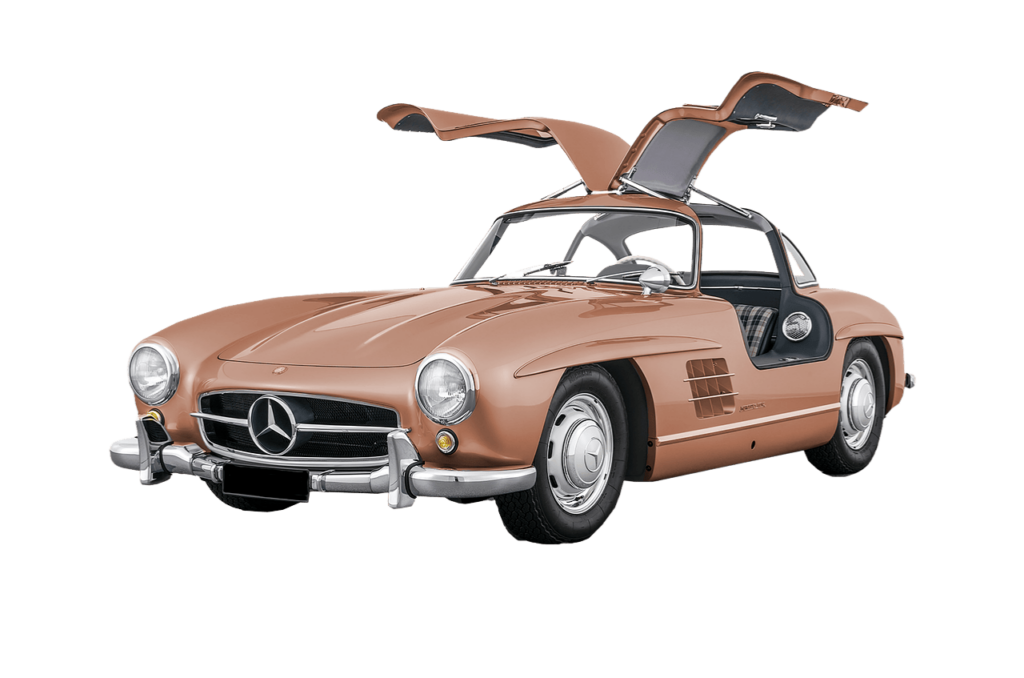
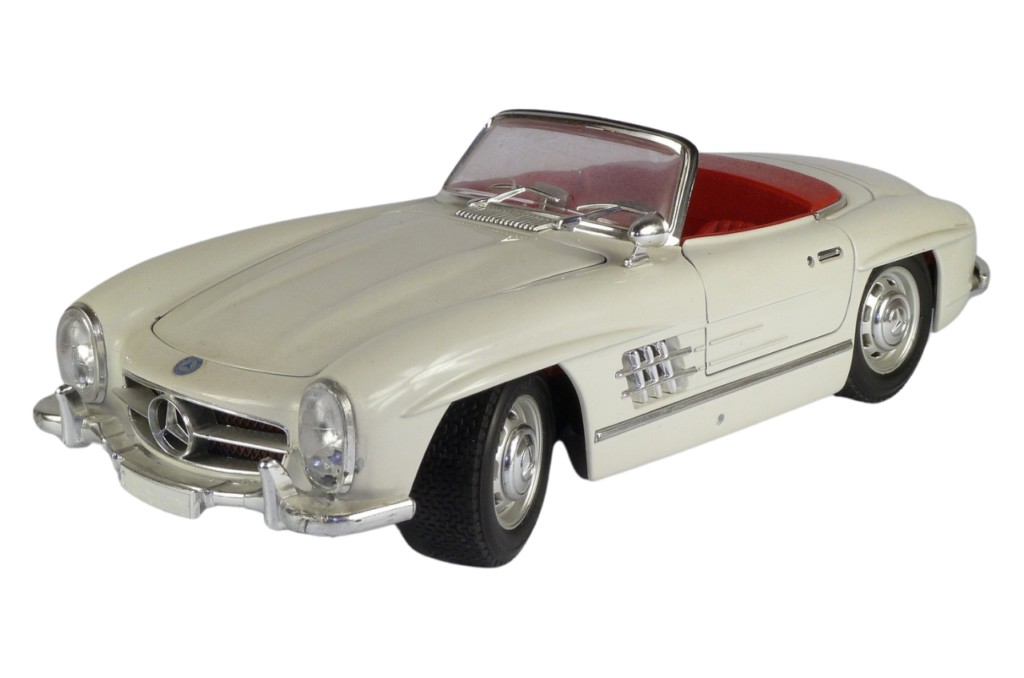
300 SL Gullwing
1954 – 1957
300 SL Roaster
1957 – 1963
The Mercedes-Benz 300 SL W198 is one of the most iconic and beautiful (sports) cars of all time. The model was produced in two versions: the 300 SL Gullwing coupe, famous for its unique wing doors, and the 300 SL Roadster convertible, which is a more comfortable and practical version of the Gullwing. Prices for these models typically exceed €1.000.000, making them by far the most expensive in their segment. With only 1.400 Gullwings and 1.858 Roadsters ever produced, the 300 SL W198 is exceptionally rare.
Advantages:
- Iconic design
- Sporty and thrilling driving experience
- Rare and valuable
Disadvantages:
- Extremely expensive to purchase, maintain and restore
- Limited space and comfort
- Driving requires effort – not ideal for comfortable cruising
2. Mercedes-Benz 190 SL W121

- 1955 – 1963
- M121 1.9 liter engine
- 105 hp
- € 75K – 230K
Driving a Mercedes 190 SL is a unique and impressive experience. Despite having the lowest engine power among the well-known SL models, it still offers a surprisingly smooth and sporty driving experience. With fewer comfort systems than modern cars, driving the 190 SL feels like a pure and authentic experience. Every 190 SL is unique, making each drive a personal journey. This makes it an ideal classic SL for cruising in style, especially when the sun is shining.
Advantages:
- Elegant and timeless design with a classic roadster look
- Smooth and enjoyable driving experience
- More affordable compared to the 300 SL
- Some may find it slightly ‘underpowered’ for sporty driving
- Older design makes it less practical for frequent or spontaneous use
3. Mercedes-Benz Pagode W113
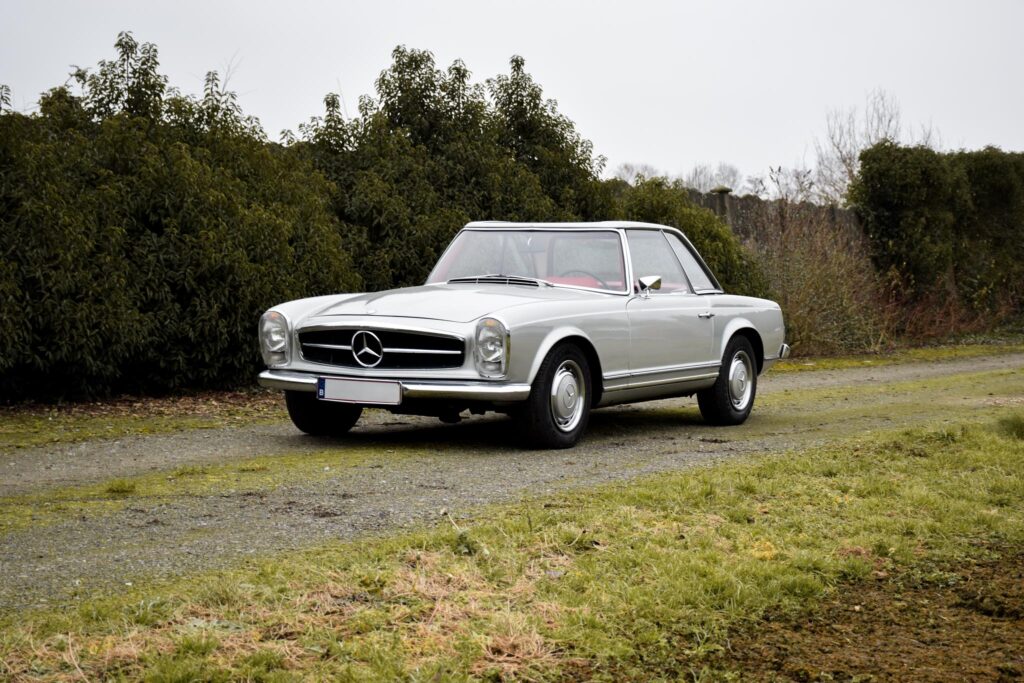
- 1963 – 1971
- 6-cylinder engine
- 150 -170 hp
- € 75K – 250K
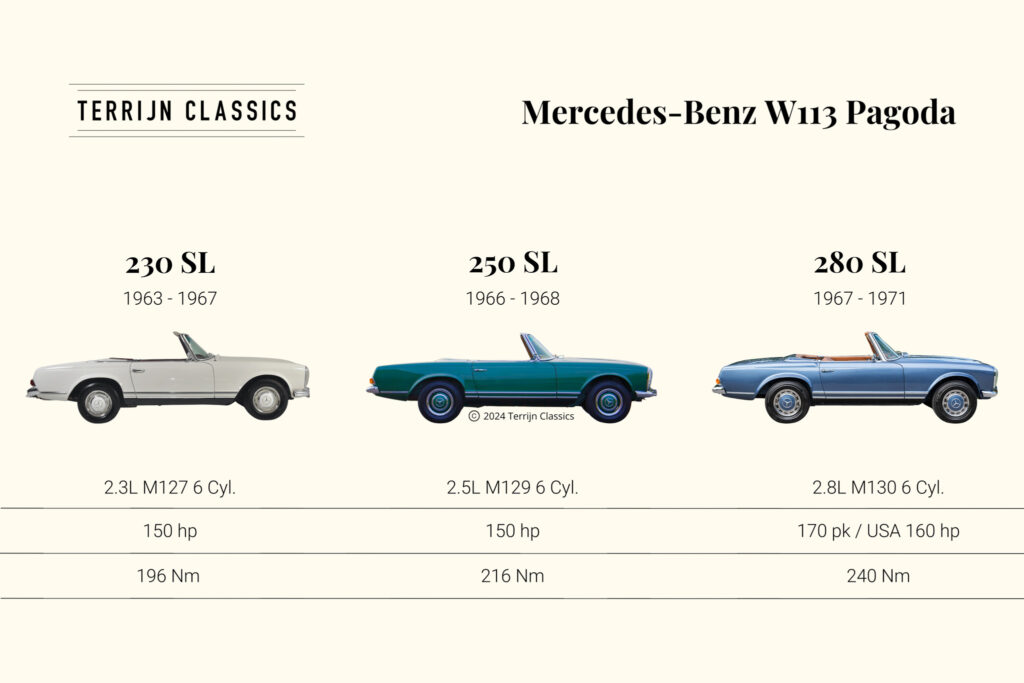
Click here for the W113 model overview.
The Mercedes Pagoda (W113), the iconic model from the 1960s, combines elegant design with advanced technology. Featuring six-cylinder engines as an upgrade from the previous generation, the Pagoda delivers more power. This model also introduced key comfort features such as an automatic transmission, power windows, and power steering, enhancing the driving experience. Take a look at the W113 Pagoda model overview for all the details.
Advantages:
- Timeless design with a unique “pagoda roof”
- Comfortable cruising with enough power for sporty driving
- Technically very reliable when in good condition
- Restoration work is very expensive and often necessary for many cars
- Early models often lack many features
230 SL:
- 1963 – 1967
- M127 2.3 liter engine
- 150 hp
250 SL:
- 1966 – 1968
- M129 2.5 liter engine
- 150 hp
280 SL:
- 1967 – 1971
- M130 2.8 liter engine
- 170 hp
4. Mercedes-Benz R107
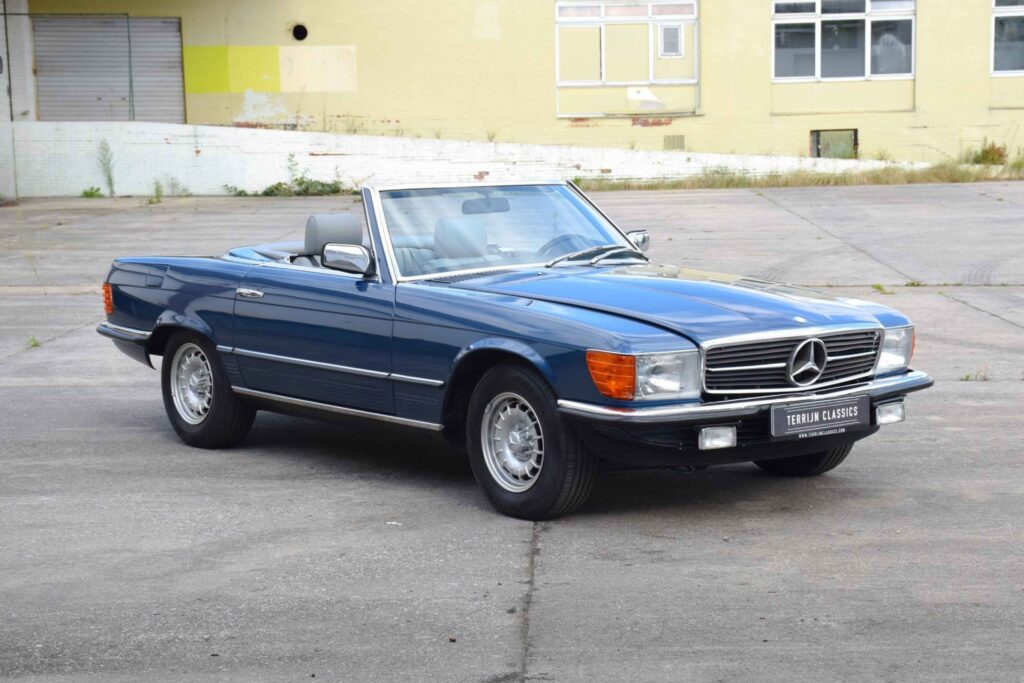
- 3 generations from 1971 – 1989
- Engine: 280 SL – 560 SL
- 155 – 245 hp
- € 30K – 90K
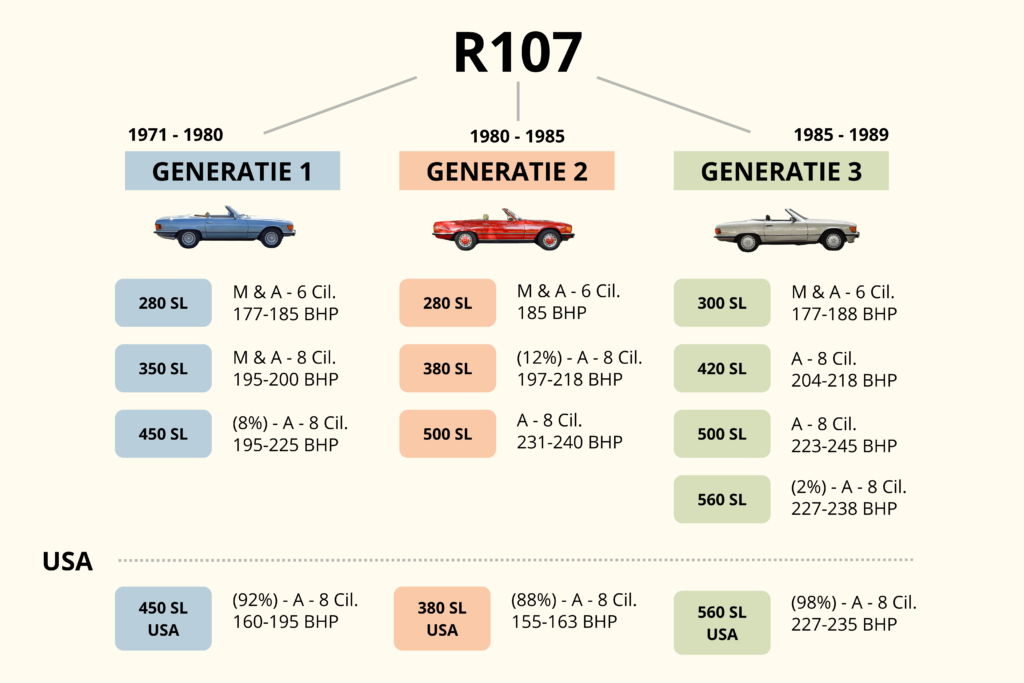
Click here for the R107 model overview.
The Mercedes R107 is gaining significant popularity among the classic Mercedes SL models. It offers the perfect balance between modern comfort and the timeless elegance of a classic car, making it ideal for long drives and even semi-daily use. For many, the R107 is the perfect classic car due to its versatility and high build quality. For more information about this model, be sure to check out our Mercedes-Benz R107 model overview.
Advantages:
- Classic look with enough modern features for semi-daily use
- Excellent price-to-quality ratio, making it the most appealing Mercedes SL classic car at the moment
- Very reliable, well-built and safe
- Neglected maintenance and repairs are often an issue, making this an important factor to consider when purchasing.
- Relatively heavy, more of a powerful cruiser than a pure sports car
5. Mercedes-Benz R129
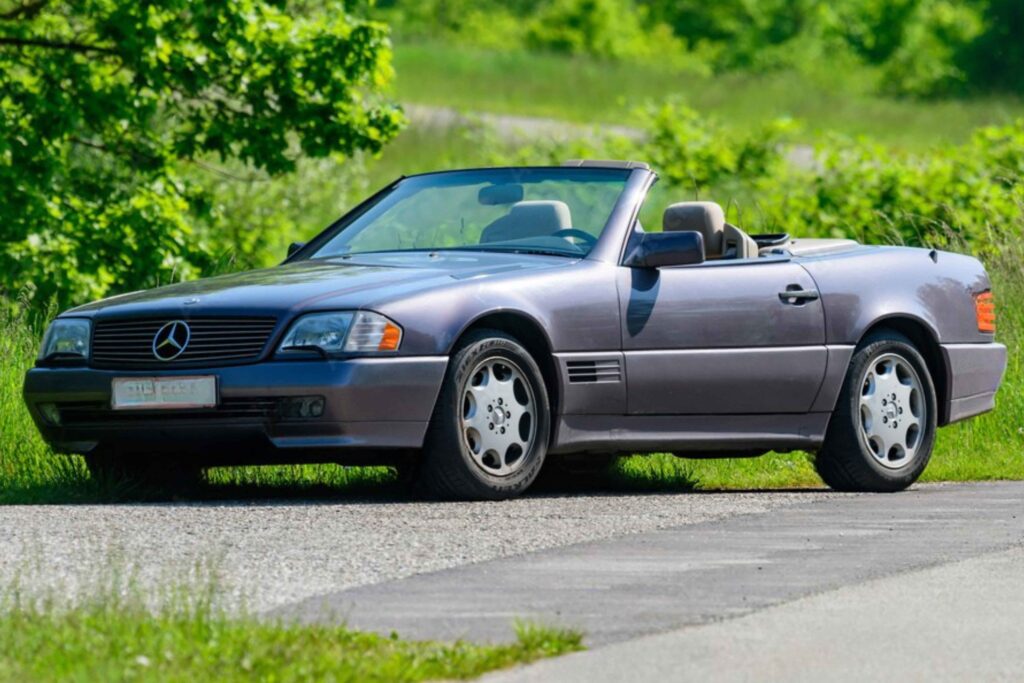
- 1989 – 2001
- Engine: 280 SL – 600 SL
- 193 – 394 hp
- € 20K – 50K
The Mercedes-Benz R129 is the last generation SL considered a classic Mercedes. The launch of this model marked the beginning of a new era in the automotive industry, where electronics started to play a major role. This makes the R129 particularly comfortable and practical to drive, with innovations such as an electronically operated roof.
Advantages:
- Very modern, with comfort comparable to modern cars
The most engine power of all Mercedes SL classic cars, depending on the model
- Often has electronic issues and is complex to repair
- Not all of these cars qualify for the classic car regulations in Belgium
Frequently asked questions about the Mercedes SL classic car models
When considering a Mercedes-Benz SL classic car, many questions often arise. In this section, we provide insights on various topics (click on the desired question to view the answer). Still have other questions? Feel free to contact us – we’re happy to assist you!
This largely depends on your budget and your intended use for the car. Our advice is always to purchase a model in good condition. For example, if you have a budget of €80.000, it’s better to choose a pristine Mercedes R107 in excellent condition rather than spending your entire budget on a Mercedes Pagoda that requires significant work. This way, you avoid buying a car that brings more problems and frustrations than enjoyment and cherished memories.
If your budget allows you to choose from all Mercedes SL models, think carefully about how you plan to use the car. Will you only drive it on sunny Sundays, or do you intend to use it almost daily?
From its very first generation, the SL was positioned in the most luxurious segment of cars. As a result, you can expect exceptionally high build quality. Just as it is today, buying a new SL was a dream for many but attainable for only a few. For comparison, Mercedes-Benz now sells the latest generation SL for €150.000 to €250.000. From the Mercedes 190 SL in the 1950s to the R129 in the 1990s, the SL has always been a car that most people could only dream of owning.
Value retention and a smart financial investment
Over the years, classic Mercedes SL models have shown remarkable stability in value, rarely experiencing significant peaks or drops. After about 20–25 years, each model typically hits a low point in value, only to steadily increase year after year. Models from the 1950s and 1960s have already undergone impressive value appreciation and have proven to be solid investments. SL classics from the 1970s, 1980s, and 1990s are now gaining significant traction.
In Belgium, like all classic cars, they are also highly advantageous in terms of taxes—especially for those who appreciate larger engines. All classic cars pay a fixed annual fee, regardless of engine size or power, amounting to approximately €105 per year. The one-time registration tax is minimal as well, around €55.
Highly versatile and perfect for leisure use
One of the most frequent comments we hear about classic SLs is how practical they are. Thanks to their exceptional build quality, they can be used regularly and without hesitation, blending seamlessly into modern traffic. With ample trunk space for road trips and user-friendly features, they’re highly reliable and ready whenever you need them. An SL is not a car to keep locked in the garage—it’s a car to truly enjoy.Sporty and powerful, yet comfortable
A classic Mercedes SL was never designed for those who want to drive fast all the time or take corners at high speeds. Mercedes-Benz always understood that most SL owners enjoy occasional spirited driving but spend 95% of the time cruising. A stiff, overly sporty suspension would only be enjoyable 5% of the time, while being unpleasant and uncomfortable the rest of the time.
It’s not uncommon to see customers switch from a Porsche 911 to a Mercedes SL for this reason—often because their partner no longer wants to ride along in the stiffer and less comfortable Porsche. The SL strikes the perfect balance between sportiness and comfort, making it an ideal classic for those who value both power and a smooth ride.
At the time, Mercedes-Benz had three major segments. The SL-Class, S-Class, and E-Class have existed for a very long time. While they weren’t always named as such, they are the direct predecessors of these segments. In the 1980s, a fourth segment was introduced with the C-Class, in the form of the W201. For a complete overview of all existing models, you can visit our Mercedes-Benz model overview.

